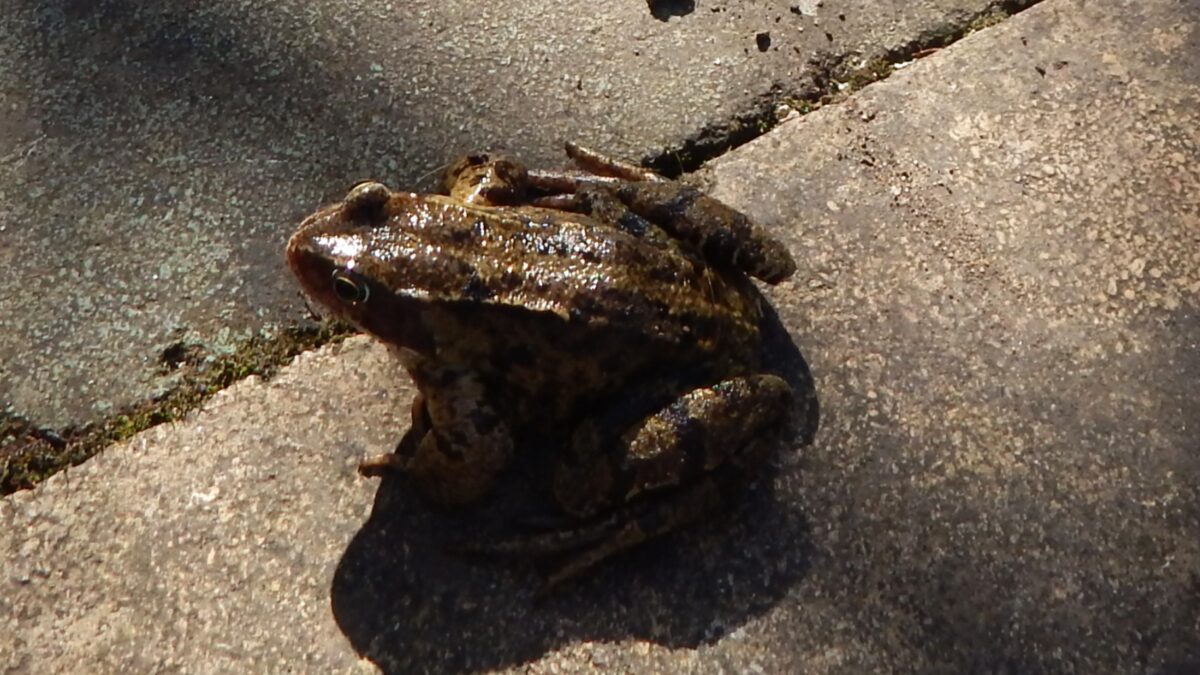Last week, I estimated the proportion of frogs eggs that become mature adults. I wanted to know what wildlife groups were saying. So I trawled the internet. An assortment of figures are quoted for eggs to mature adult. 1 in 50 is a common quote, though 1 in 12,000 is heard in our garden, an enormous span.
I found this paragraph on the Field Studies Council website:
‘Unfortunately only about 2% of eggs eventually become breeding adults. Frog spawn can freeze, dry out or become diseased. Then at the tadpole stage, many animals are eaten by predators, including newts and diving beetles. And finally newly emerged frogs are gobbled up in their hundreds by reptiles, birds and mammals.’
I thought this figure, 2% (or 1 in 50), to be too high a survival rate. I emailed the Field Studies Council to ask where it came from. I got this reply from Dr Rebecca Farley-Brown (Head of Publications at FSC):
‘I would not say our figure is precise, it is intended as a guide: on average 1 or 2% of eggs develop fully and then mature to become breeding adults. Tadpole survival varies year to year and pond to pond. The figures will have been based on the authors experience and the literature. Similar figures are given by ARC.’
I note that the Woodland Trust also say one in fifty eggs become adults which is another way of saying 2% survival. They also say the source was ARC. Leicester and Rutland Wildlife Trust repeat this figure.
I went on the ARC (Amphibian & Reptile Conservation Trust) website, and found this paragraph:
‘A popular statistic says that around one in fifty of the eggs laid in the pond will actually make it out of the pond as a froglet. The rest will be eaten by pond predators that might include fish (if present), dragonfly larvae or newts. Having large numbers of tadpoles can also lead to intense competition between individuals for food, meaning again that numbers of tadpoles will naturally thin out. Of the froglets that leave the pond, only a handful will make it to adulthood which can be as low as 1% – the rest will get eaten by other predators including , blackbirds, grass snakes, crows, magpies, hedgehogs, foxes and badgers.’
This is not the same figure as the Field Studies Council quote (1 in 50). The above paragraph says 1 in 50 eggs will leave the pond as a froglet. And 1 in 100 of these make it to adulthood. Or egg to adult as low as 1 in 5000. After getting this, I had replied to the Woodland Trust, saying they had misinterpreted the ARC figures. They emailed me back, saying they have now updated the page. I note that they now have no survival figure at all.
I got this reply from Froglife when I asked the proportion of survival (from Kathy Wormald,
Chief Executive Officer):
‘Common frogs experience very high levels of mortality during development. If the average common frog lays 3,000 eggs, 2,790 will survive to hatching (93% remaining), 120 will survive to metamorphosis (4% remaining) and just 4-5 to adult (0.15% remaining). Therefore providing suitable ponds for frogs to breed with few fish and other predators is important to aid in their survival.’
Converting Froglife’s to ratios over the lifecycle: 3000 eggs, with 4 to 5 surviving to adulthood, that’s 1 to 750, or 1 to 600. 0.15% is 0.15 in a 100 or roughly 1 to 700.
I have searched on line for the 1 in 12,000 survival figure that I have heard repeated by garden volunteers, but I have found no source for it. I find it an unlikely figure as in some years there would be no adults at all.
Comparing the survival ratios of eggs to mature adults from various bodies:
Field Studies Council 1 in 50
Woodland Trust 1 in 50
Leicester & Rutland Wildlife Trust 1 in 50
Amphibian & Reptile Council 1 in 5000
Froglife 1 in 700
To my knowledge none of these are backed up by experimental work. Experimental work would be very difficult and costly. Counting frogspawn can be done, but how do you count froglets? And then maturing frogs, which are scattered and hide themselves in woodpiles and under leaves. And even, if you were able to do this, it would only apply to one pond, as different conditions of predation, micro-climate, and disease apply elsewhere.
I have estimated that we have 8000 eggs in our 2025 spawn. 8000 eggs at 1 in 50 would result in 160 adults, at 1 in 5000 would result in 1.6 adults, at 1 in 12,000 would result in 0.7 adults, at 1 in 700 would result in 11 adults. Of these ratios, I find the latter figure more likely. Enough to keep spawn coming in future years, without being awash with adult frogs. The oft repeated 1 in 50 would result in too high a number of mature frogs, and 1 in 12,000 would lead to extinction.

